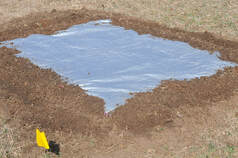 If you plan to develop or add to your fruit garden next year, now is a good time to begin preparing the planting site. Grass areas should be tilled so grass does not compete with the fruit plants for soil moisture and nutrients. Have the soil analyzed for plant nutrients. Your local K-State Research and Extension agents have information to guide you in taking the soil sample. From that sample, the agent can provide recommendations on what and how much fertilizer to add to correct nutrient deficiencies. Organic materials such as compost, grass clippings, leaves, hay, straw or dried manure, can be tilled into the soil to help improve its condition. Time and weather conditions generally are more suitable in the fall than in the late winter and spring for preparing soil. If fruit plants can be set by early April, they will have developed a stronger root system to support plant growth than they would if planted later. If there are only a few plants to be planted, consider tarping each planting area to guard against a wet spring, delaying planting after plants are shipped and received. Also, fruit tree planting can be done in the fall but plants may need to be watered during the winter if the weather is warm and dry. (Ward Upham) 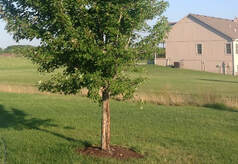 Many young, smooth, thin-barked trees such as honey locusts, fruit trees, ashes, oaks, maples, lindens, and willows are susceptible to sunscald and bark cracks. Sunscald normally develops on the south or southwest side of the tree during late winter. Sunny, warm winter days may heat the bark to relatively high temperatures. Research done in Georgia has shown that the southwest side of the trunk of a peach tree can be 40 degrees warmer than shaded bark. This warming action can cause a loss of cold hardiness of the bark tissue resulting in cells becoming active. These cells then become susceptible to lethal freezing when the temperature drops at night. The damaged bark tissue becomes sunken and discolored in late spring. Damaged bark will eventually crack and slough off. Trees often recover but need TLC — especially watering during dry weather. Applying a light-colored tree wrap from the ground to the start of the first branches can protect recently planted trees. This should be done in October to November and removed the following March. Failure to remove the tree wrap in the spring can prove detrimental to the tree. (Ward Upham)  We are starting to receive questions on whether it is best to cut back ornamental grasses in the fall or spring. As a rule, ornamental grasses should not be cut back while green because they need time to move the energy found in the foliage into the roots. Even when browned by cold weather, most gardeners will leave the foliage until spring because of the interest it adds to winter landscapes. Early March is the preferred time to cut back these plants. However, dry foliage is extremely flammable and should be removed in the fall from areas where it is a fire hazard. Another question we often receive is whether we can divide ornamental grasses in the fall. Spring is the preferred time because divisions done in the fall may not root well enough to survive the winter. (Ward Upham) 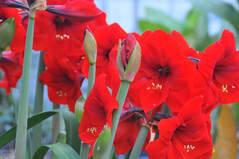 With proper care, amaryllis will bloom year after year. Bring the pot in before the first frost and place in a dark location. Withhold water so leaves have a chance to dry completely. Then cut them off close to the top of the bulb. Amaryllis needs to rest for at least a month before the plant is started back into growth. It takes an additional six to eight weeks for the plant to flower. When you are ready for amaryllis to resume growth, water thoroughly and place the plant in a warm, sunny location. Do not water again until the roots are well developed because bulb rot is a concern. Amaryllis needs temperatures between 50 and 60 degrees during the period before flowering. Higher temperatures can weaken leaves. The flower bud may start to appear right away or the plant may remain dormant for a period of time, but eventually all mature bulbs do bloom if they have been given proper care during the growing season. Keep the plant in a cool location and out of direct sunlight when the flower buds begin to show color so that the flowers last longer. Amaryllis can remain in bloom for about a month. (Ward Upham) 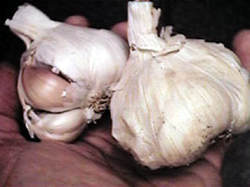 October is a good time to plant garlic (Allium sativum) if you want large quality cloves next summer. Apply 3 pounds of 10-10-10 fertilizer per 100 square feet and mix into the soil before planting or fertilize according to soil test. Plant individual cloves point up and spaced 6 inches apart and 1 to 2 inches deep. The larger the clove planted, the larger the bulb at harvest. Water in well and mulch with straw to conserve soil warmth and encourage good establishment. Harvest will not occur until next summer. Test dig when the lower 1/3 of the foliage is yellow. If the cloves have segmented, it is time to harvest. If they haven't segmented, wait another week or two. Elephant garlic (Allium ampeloprasum) should also be planted now. It is a plant with a milder garlic flavor and is actually a closer relative to the leek than to true garlic. (Ward Upham) 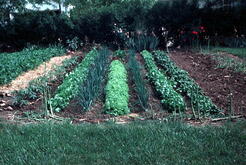 Rotating vegetable crops is a standard way of helping prevent disease from being carried over from one year to the next. Rotation means that crops are moved to different areas of the garden each year. Planting the same crop, or a related crop, in the same area each year can lead to a build-up of disease. Also, different crops vary in the depth and density of the root system as well as extract different levels of nutrients. As a rule, cool-season crops such as cabbage, peas, lettuce and onions have relatively sparse, shallow root systems and warm-season crops such as tomatoes, peppers and melons have deeper, better developed root systems. Therefore, it can be helpful to rotate warm-season and cool-season crops. As mentioned earlier, it is also a good idea to avoid planting closely related crops in the same area as diseases may be shared among them. For example, tomatoes, potatoes, peppers and eggplant are closely related. Also, broccoli, cauliflower, cabbage and brussels sprouts share many characteristics in common. For example, do not plant cabbage where broccoli was the previous year or tomatoes where the peppers were. So, why is this important to bring this up in the fall? Now is the time to make a sketch of your garden so that the layout is not forgotten when it is time to plant next year. (Ward Upham) 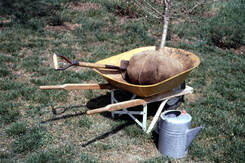 The fall season can be an excellent time to plant trees. During the spring, soils are cold and may be so wet that low oxygen levels inhibit root growth. The warm and moist soils normally associated with fall encourage root growth. Fall root growth means the tree becomes established months before a spring-planted tree and is better able to withstand summer stresses. The best time to plant trees in the fall is early September to late October. This is early enough that roots can become established before the ground freezes. Unfortunately, certain trees do not produce significant root growth during the fall and are better planted in the spring. These include beech, birch, redbud, magnolia, tulip poplar, willow oak, scarlet oak, black oak, willows, and dogwood. Fall-planted trees require some special care. Remember, that roots are actively growing even though the top is dormant. Make sure the soil stays moist but not soggy. This may require watering not only in the fall but also during the winter months if we experience warm spells that dry the soil. Mulch also is helpful because it minimizes moisture loss and slows the cooling of the soil so root growth continues as long as possible. (Ward Upham) 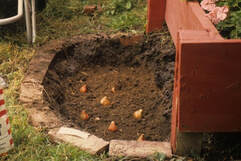 Late September through October is an excellent time to plant spring-flowering bulbs such as crocus, tulips, and daffodils. These plants need to develop roots in the fall and must meet a chilling requirement over the winter in order to bloom in the spring. Choose a planting site that has full sun to partial shade. The ideal soil would be a sandy loam, but even poor soils can be used if organic material such as peat moss, compost, or aged bark is mixed in. For example, a heavy clay can be amended by mixing in one-third to one-half organic material. Soil pH should be between 6.0 and 7.0. Bulbs need good aeration as well as good drainage for proper development. It is best if the bulbs are given 12 inches of prepared soil. If one-third organic material were added, this would require mixing 4 inches of organic material with 8 inches of soil. Incorporate about 3 pounds of a complete fertilizer such as a 5-10-5 per 100 square feet during preparation or fertilize according to soil test. Planting depths vary depending on the size of the bulbs. For example, tulips and hyacinths are set about 6 inches deep, and daffodils are put 6 to 8 inches deep. Smaller bulbs are planted shallower. As a rule of thumb, bulbs are planted two to three times as deep as their width. Planting depth is the distance from the bottom of the bulb to the top of the soil. Large bulbs are normally spaced 4 to 6 inches apart, and small bulbs about 1 to 2 inches. Planting in clumps or irregular masses produces a better display than planting singly. After placing the bulbs at the proper depth, replace half the soil and add water. This will settle the soil around the bulbs and provide good bulb/soil contact. Add the remaining soil and water again. Although there will be no top growth in the fall, the roots are developing, so soil needs to be kept moist but not soggy. Mulch can be added after the soil has frozen to prevent small bulbs from being heaved out of the soil by alternate freezing and thawing. (Ward Upham) |
AuthorsCynthia Domenghini runs the Horticulture Response Center in the Department of Horticulture and Natural Resources at Kansas State University. Other contributors include K-State Extension Specialists. Archives
March 2024
Categories
All
|
| K-State Research and Extension Horticulture Newsletter |
|
 RSS Feed
RSS Feed
